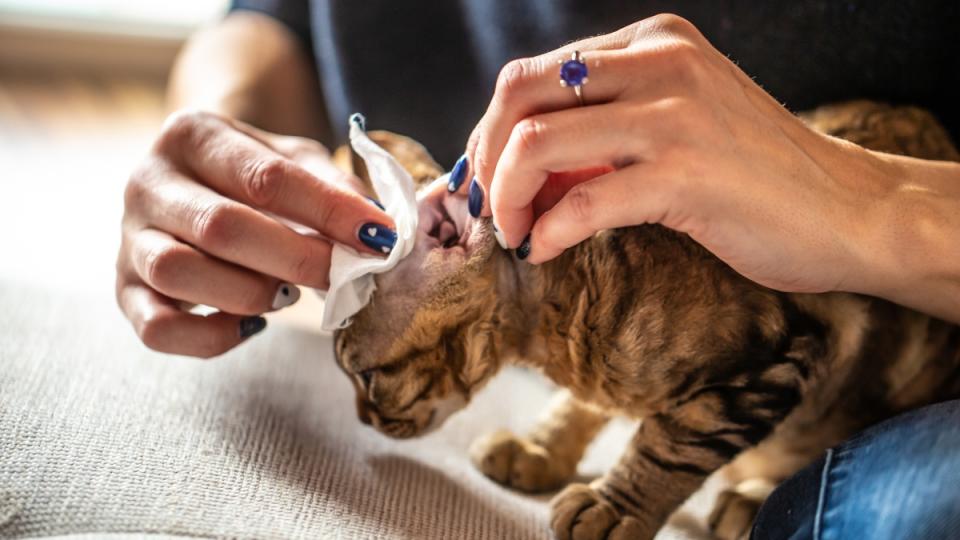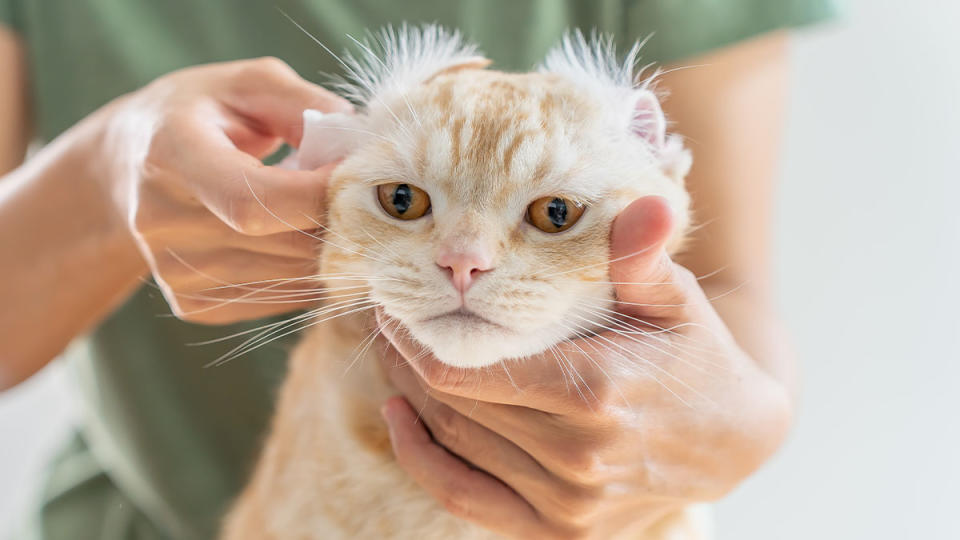Cleaning Cat Ears: Here's How to Do It Without Triggering a Hissy Fit
For us cat lovers, we want nothing more than for our furry friends to be happy and healthy. Trouble is, when it comes to the "healthy" part, felines often are not fans of routine wellness care. In fact, anyone who's tried to clean their kitty's ears has probably encountered quite the sour puss. That's why we talked to a pet pro about how to make cleaning cat ears as easy as possible — for everyone involved. Keep reading to learn how you can tell if those ears need cleaning and how to get it done without a cat fight.
How to tell if your cat's ears need cleaning
You might be thinking — wouldn't it be obvious? If your cat is constantly pawing at her ears, it's a good sign that her ears are bothering her. And while that's true, it's not the only indicator. Keep reading for some other ways to tell that it's time to get cleaning those cat ears.
1. Head shaking
Head shaking is a common sign that your cat's ears are uncomfortable and itchy. Cats shake their heads when their ears itch in an attempt to alleviate discomfort or even dislodge any foreign body that's bothering them. If your cat's head shaking has become obsessive, it may be worth taking them to the vet since this behavior can also be a sign of an ear infection or ear mites, which can't be totally resolved by cleaning alone.
"Cats are generally clean animals, and if you observe your feline friend excessively scratching their ears or vigorously shaking their head, it's time to take a closer look," says Sara Ochoa, DVM and co-founder of How To Pets. "It could be a sign of ear irritation, mites or infections, which may require cleaning or treatment."
2. Odor
Usually, your cat's ears are mostly odorless. But if Fluffy jumps up in your lap and you get a whiff of something unpleasant and yeasty, the smell may be coming from her ears. This is an indicator that a quick ear scrub wouldn't hurt. If the scent becomes strong, however, run it by your vet — in some cases, it can be a sign of infection.
"One of the telltale signs that your cat's ears need cleaning is a strong, unpleasant odor," says Dr. Ochoa. "If you notice a fishy or foul smell coming from your cat's ears, it could indicate an ear infection or excessive wax buildup. In this case, it's essential to consult your veterinarian for further examination."
3. Visible debris
Gently hold the tip of your cat's ear and roll it backward so you can see deep inside it. "During your regular bonding sessions with your cat, it's a good idea to occasionally check their ears for any abnormal discharge or wax buildup," says Dr. Ochoa. "A small amount of wax is normal, but if you notice a considerable amount or a colored discharge like yellow or black, it could suggest the need for cleaning."
RELATED: How to Trim Cat Nails: Vets Reveal the Secrets to Make It Stress-Free for Everyone
Tips for cleaning cat ears

Ready to get your kitty's ears sparkling clean? It doesn't have to be a fight. Check out this simple step-by-step guide to make cleaning time as stress-free as possible:
1. Create the right environment
"Start with a calm, reassuring environment to avoid stressing out your cat," says pet professional Sharon Waddington. "A relaxed cat makes everything easier." She also recommends regularly handling your cat's ears so she's used to the sensation of them being touched. That ways, she isn't startled when it's time for cleaning.
2. Swaddle
Sit down comfortably with your cat. If you expect your cat to resist, try wrapping her in a comfortable blanket or soft towel, being sure that swaddle includes all four of her paws, and snuggling her into your lap. Remain calm and positive — "a gentle petting session or offering treats can help keep your cat calm," adds Waddington.
3. Prepare the ear
With one hand, gently hold and slightly pull back the tip of your cat's ear flap. This will straighten her ear canal, making it easier to access.

"Carefully examine your cat's ears for any signs of redness, discharge, foul odor, or swelling," Dr. Ochoa explains, "If you notice anything unusual, it is recommended to consult your veterinarian before proceeding with cleaning. It's also important to note that if your cat's ears are excessively dirty or inflamed, it is best to leave the cleaning to the professionals."
4. Secure your solution
Use a vet-approved cleaning solution made specifically for cleaning cat ears. One to try: Zymox Pet Ear Cleanser (Buy from Petsmart, $12.99). Don't use Q-tips, or anything that may puncture or hurt her delicate ear. "And avoid anything too harsh like alcohol or hydrogen peroxide," says Waddington. You may want to have some cotton balls and paper towels on hand to clean up any spillage.
5. Apply and remove solution
"Gently lift your cat's ear flap and apply the recommended amount of cleaner into the ear canal," Dr. Ochoa says. "Be cautious not to insert the applicator too deeply. Massage the base of the ear (just below the ear canal) for about 20 seconds to allow the cleaner to work its magic." Afterward, wipe away any external wax and debris with a cotton pad. And if you cat is shaking her head, let her! It'll help expel any remaining solution and debris.
6. Repeat and reward
Repeat the process with your cat's other ear. At the end, give your cat plenty of treats for being so patient and allowing you to clean her ears. "Positive reinforcement will help create a positive association and make future cleanings easier for both of you," Dr. Ochoa says. (And then treat yourself by clicking through and seeing these adorable photos of fall-loving cats!)
Important notes about cleaning
Your cat may exhibit signs of stress, especially if she isn't used to having her ears touched. However, if your cat seems to be in pain in any part of the process, stop immediately. This may be an indicator that she has an underlying health problem that goes beyond routine ear debris.
Prefer a visual step-by-step? Check out the video below by The Cat Butler.
How often to clean cat ears
"It's recommended to check your cat's ears once per week. Cleaning frequency, on the other hand, isn't one-size-fits-all. Generally, a healthy cat's ears should be self-cleaning," Dr. Ochoa says. And cleaning them too often, as well as cleaning them when they don't need it, may lead to irritation and infection.
When should to take your cat to the vet
"Any abnormal discharge or inflammation in the ears should be cause for concern. Discharge can be waxy or pus-like, while redness may indicate inflammation or infection," says Dr. Ochoa. "If you notice a sudden or gradual change in your cat's hearing, it could be due to an ear issue. They may not respond to sounds as they normally would or seem disoriented. "
Click through to learn more on cats:
Why Do Cats Headbutt — Vets Reveal 4 Things They May Be Trying to Tell You
Cat Trilling: Vets Reveal the Secret Message Behind Those Cute Kitty Chirps
The World’s Smallest Cat Breeds Are Big-Time Adorable — Here Are Photos to Prove It
First For Women aims to feature only the best products and services. We update when possible, but deals expire and prices can change. If you buy something via one of our links, we may earn a commission.
Questions? Reach us at shop@firstforwomen.com

